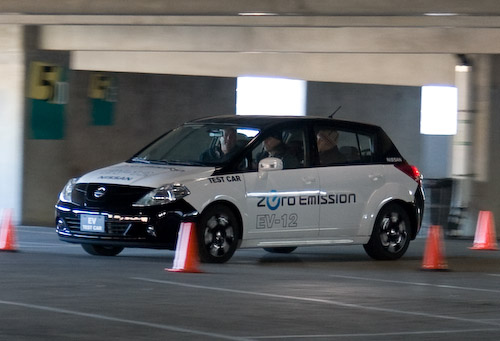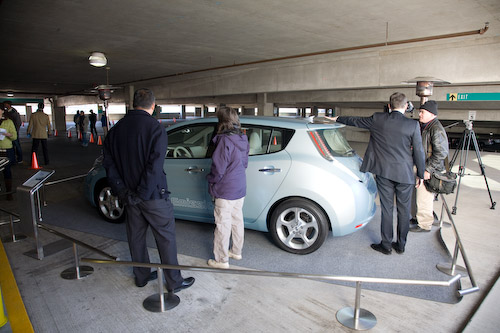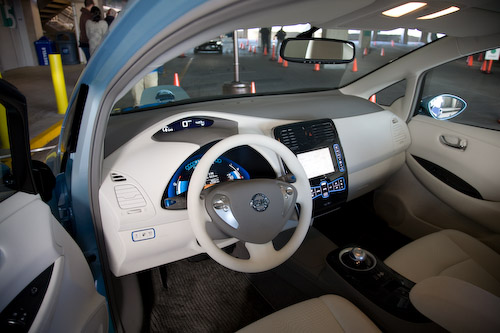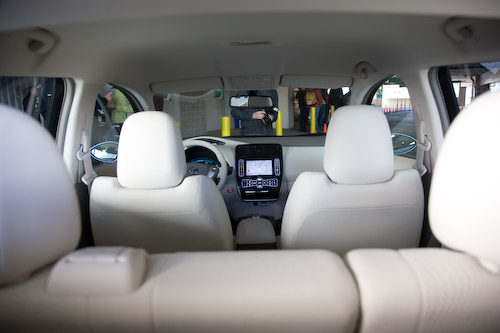Cathy and I are both puzzle nuts. We have two daily puzzle calendars to jump start our brains during breakfast. Cathy has a diverse taste in puzzles and is frequently working her way through a book of Japanese puzzles while I'm reading the newspaper at night. I'm not talking about Sudoku, she chews through puzzles like Kakuro and Hanji.
In addition to solving puzzles, she also likes to create puzzles, which is much harder and far more time-consuming than solving them. Quite often, I get a sequence of puzzles on my birthday each of which has an embedded clue to the next puzzle, eventually leading to my birthday gift.
This year we were extremely busy for the two weeks leading up to my birthday. We spent a week in Hawaii prepping our condo for a new rental agency, then spent the next week being EV groupies attending all of the Nissan Leaf events in Seattle, then on Saturday Cathy was the head judge at the Washington State FIRST LEGO League Championship. Anyway, we were busy and I was sure Cathy didn't have time to create any puzzles.
So, I was quite to surprised to find a puzzle sitting on the bar at breakfast. I like doing Marilyn vos Savant's Numbrix puzzles that accompany her column in Parade magazine, so Cathy created a jumbo size version. This is probably the only puzzle format for which I am more practiced at solving than Cathy, but she still managed to create a puzzle in that format, larger than normal, challenging for the type, and yet still solvable.
 It was a good puzzle and I enjoyed solving it. If you want to try, download this PDF version. When I was done, I was amazed she had created such a nice puzzle and couldn't imagine when she had time. I wondered if it was the first clue of a treasure hunt, but I didn't want to assume it was and have her think I was disappointed to have just a single puzzle. I also couldn't imagine how solving a Numbrix could yield a clue to another puzzle. While all of this was running through my brain, she was giving me the look that says, "you're not done yet." Stop reading now if you want to try to find the clue to the next puzzle without a hint.
It was a good puzzle and I enjoyed solving it. If you want to try, download this PDF version. When I was done, I was amazed she had created such a nice puzzle and couldn't imagine when she had time. I wondered if it was the first clue of a treasure hunt, but I didn't want to assume it was and have her think I was disappointed to have just a single puzzle. I also couldn't imagine how solving a Numbrix could yield a clue to another puzzle. While all of this was running through my brain, she was giving me the look that says, "you're not done yet." Stop reading now if you want to try to find the clue to the next puzzle without a hint.
While I was solving the puzzle, I realized that sometimes when I work these puzzles, instead of writing in the numbers, I just draw the path through the sequence connecting the centers of the boxes in order. It actually occurred to me that might be interesting, but I couldn't imagine how that could yield a message. Cathy realized that by drawing lines in the manner I described, there are 7 letters that can be easily formed: CEHISUY plus maybe a couple of others like T and L that might work but leave odd shaped areas to be filled to complete rectangular blocks. If you solve the puzzle then draw the sequence line you'll see a word that told me where to look for the next puzzle.
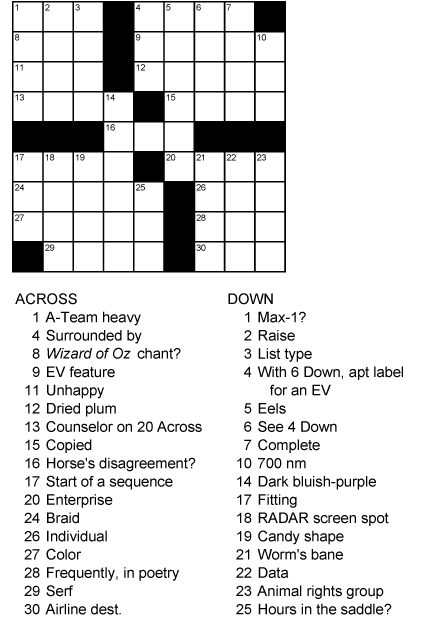 If you'd like to try working this one on paper, download the PDF version. Four of the clues require a bit of inside knowledge, but it's probably doable anyway. Stop reading now if you want to try it without any hints, if you perhaps know the cars we drive, enjoy shows at the Village Theatre and were an applications programmer at Microsoft in the 1990s.
If you'd like to try working this one on paper, download the PDF version. Four of the clues require a bit of inside knowledge, but it's probably doable anyway. Stop reading now if you want to try it without any hints, if you perhaps know the cars we drive, enjoy shows at the Village Theatre and were an applications programmer at Microsoft in the 1990s.
1 Down is a reference to the Hungarian naming convention used by some programmers at Microsoft where "max" means "one more than is allowed." This photo of one of our cars will give you the answer to 4 and 6 Down. 25 Down is a reference to a line in Chasing Nicolette, but you can probably get it from the other clues without knowing the show.
In addition to solving puzzles, she also likes to create puzzles, which is much harder and far more time-consuming than solving them. Quite often, I get a sequence of puzzles on my birthday each of which has an embedded clue to the next puzzle, eventually leading to my birthday gift.
This year we were extremely busy for the two weeks leading up to my birthday. We spent a week in Hawaii prepping our condo for a new rental agency, then spent the next week being EV groupies attending all of the Nissan Leaf events in Seattle, then on Saturday Cathy was the head judge at the Washington State FIRST LEGO League Championship. Anyway, we were busy and I was sure Cathy didn't have time to create any puzzles.
So, I was quite to surprised to find a puzzle sitting on the bar at breakfast. I like doing Marilyn vos Savant's Numbrix puzzles that accompany her column in Parade magazine, so Cathy created a jumbo size version. This is probably the only puzzle format for which I am more practiced at solving than Cathy, but she still managed to create a puzzle in that format, larger than normal, challenging for the type, and yet still solvable.
 It was a good puzzle and I enjoyed solving it. If you want to try, download this PDF version. When I was done, I was amazed she had created such a nice puzzle and couldn't imagine when she had time. I wondered if it was the first clue of a treasure hunt, but I didn't want to assume it was and have her think I was disappointed to have just a single puzzle. I also couldn't imagine how solving a Numbrix could yield a clue to another puzzle. While all of this was running through my brain, she was giving me the look that says, "you're not done yet." Stop reading now if you want to try to find the clue to the next puzzle without a hint.
It was a good puzzle and I enjoyed solving it. If you want to try, download this PDF version. When I was done, I was amazed she had created such a nice puzzle and couldn't imagine when she had time. I wondered if it was the first clue of a treasure hunt, but I didn't want to assume it was and have her think I was disappointed to have just a single puzzle. I also couldn't imagine how solving a Numbrix could yield a clue to another puzzle. While all of this was running through my brain, she was giving me the look that says, "you're not done yet." Stop reading now if you want to try to find the clue to the next puzzle without a hint.While I was solving the puzzle, I realized that sometimes when I work these puzzles, instead of writing in the numbers, I just draw the path through the sequence connecting the centers of the boxes in order. It actually occurred to me that might be interesting, but I couldn't imagine how that could yield a message. Cathy realized that by drawing lines in the manner I described, there are 7 letters that can be easily formed: CEHISUY plus maybe a couple of others like T and L that might work but leave odd shaped areas to be filled to complete rectangular blocks. If you solve the puzzle then draw the sequence line you'll see a word that told me where to look for the next puzzle.
 If you'd like to try working this one on paper, download the PDF version. Four of the clues require a bit of inside knowledge, but it's probably doable anyway. Stop reading now if you want to try it without any hints, if you perhaps know the cars we drive, enjoy shows at the Village Theatre and were an applications programmer at Microsoft in the 1990s.
If you'd like to try working this one on paper, download the PDF version. Four of the clues require a bit of inside knowledge, but it's probably doable anyway. Stop reading now if you want to try it without any hints, if you perhaps know the cars we drive, enjoy shows at the Village Theatre and were an applications programmer at Microsoft in the 1990s.1 Down is a reference to the Hungarian naming convention used by some programmers at Microsoft where "max" means "one more than is allowed." This photo of one of our cars will give you the answer to 4 and 6 Down. 25 Down is a reference to a line in Chasing Nicolette, but you can probably get it from the other clues without knowing the show.
After solving that puzzle, you can find another hidden clue that told me where to find an envelope containing my birthday gift: a signed print of this xkcd comic which is an alarmingly accurate a description of what Cathy has to deal with all too often.
